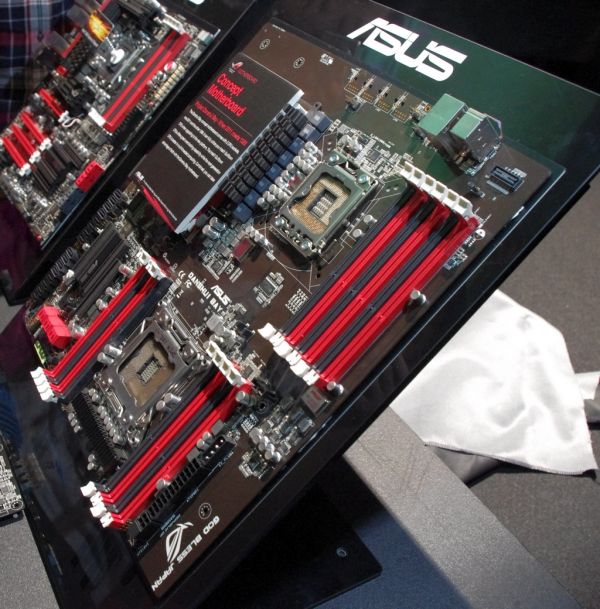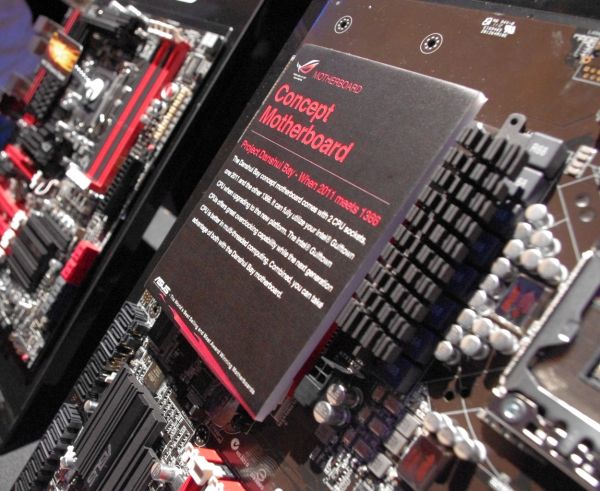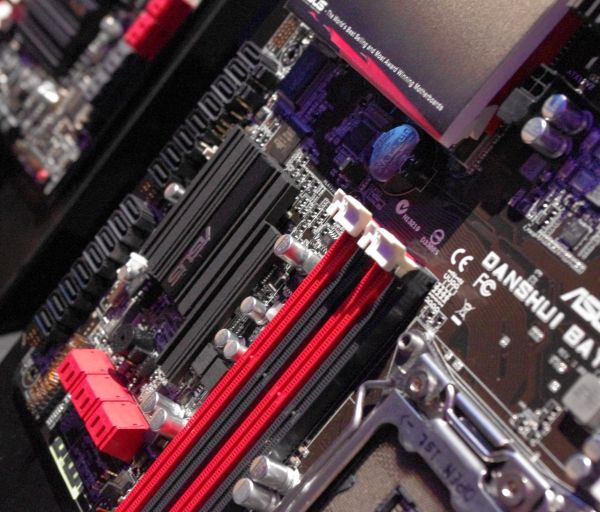Computex 2011: Danshui Bay Concept Motherboard
by Ian Cutress on June 3, 2011 7:53 PM EST- Posted in
- Computex 2011
- Motherboards
- M1000
- Asus
- Trade Shows
ASUS have been coming to Computex to sensationalize and dazzle the press with concepts for years, and this year is no different, regardless of whether something is technically feasible or not. Last year, we saw the ASUS Immensity motherboard concept that was never put into production – an X58 featuring a 5450-type integrated GPU and a Lucid Hydra chip to combine any discrete GPU combination on board. This year takes a turn for the surreal.
Introducing the Danshui Bay concept:
Simply put, ASUS are wanting to combine two chipsets on one motherboard – the X58 socket 1366, and the X79 socket 2011. If we completely disregard the technical challenges this faces, it provides the interesting idea of something that might be possible in the future: You want to upgrade your machine to the latest chipset and processor. Rather than throw your old processor away or sell it on, you could buy a motherboard that lets you harness the power of the old processor and a new processor together, in some form of chimerism.
As for the technical challenges in producing such a product, I could reel off a whole list. For a start, chipsets are not designed to talk to each other. Processors need dual QPI links to talk to each other of the same model – how that would work with different socket processors with different caches and core counts is also a mystery, as with 1366 you would need an appropriate Xeon. With two chipsets, you’ll have to have a different set of memory for each processor, and possibly getting a mismatch there based on dual/tri/quad channel memory. Each processor requires its power and a set of PCIe each – unless you disregard the PCIe of one of the chipsets but then you would have to have at least the processor of the other socket in order to run a discrete GPU. The same goes with SATA ports, I/O connectors, USB headers, and so on.
Obviously, this board presented is a mockup – merely bits and pieces put together. It’s showing sixteen SATA 3 Gbps and six SATA 6 Gbps for a start, as well as no significant power delivery and an obscene form factor. ASUS only want to know that if there was a demand for such a product, despite the technical limitations.



















52 Comments
View All Comments
bobbozzo - Saturday, June 4, 2011 - link
That's not the point; Your old CPU with it's old socket would go on this board, PLUS a new cpu with it's new socket.Regardless, the costs to make this board probably exceed the depreciated value of the old CPU.
jabber - Saturday, June 4, 2011 - link
Ahh but you are also limited with the fact that chances are the two sockets are just one generation apart.By the time you require to upgrade from socket 1 to socket 2 on the motherboard, chances are socket 2 will also be obsolete.
Having two generations of socket doesnt really make sense unless you like paying lots of money for dual obsolete socket motherboards.
Its an interesting idea but wouldnt really work as intended. Would cause more problems than it solves.
Bindibadgi - Saturday, June 4, 2011 - link
1) There's no X58 chipset on the board, only X792) The LGA1366 CPU and LGA2011 CPU can work together at the same time
3) They talk to each other via QPI, and you need the LGA2011 CPU to talk to the X79 via DMI. So if the LGA1366 CPU wants some SATA or USB action, it has to make a call via the other CPU.
4) PCI-Express comes from the LGA2011 CPU.
The LGA1366 CPU is just there as a workhorse. It's not an ideal, native Intel platform but it's the first, working dual-CPU board with at least one LGA2011 socket ;-)
ASUS shows off this stuff to say "Hey, we can do it, we like to experiment" - who else does these days? No one moans at F1 cars because they have no luggage space. :-P
don_k - Saturday, June 4, 2011 - link
Do you mind if I ask what your sources are? :) Because if what you say is true this is even more interesting.I would say that whether or not this is buy-able will depend on the amount of PCIe lanes available and the scaling with the 1366 cpu not being able to directly access PCIe, specifically SLI scaling on such a setup.
mbf - Saturday, June 4, 2011 - link
He knows those things because he works for ASUS. :)Oh, and that's not guesswork on my part.
Apart from that this concept seems a bit unrealistic to me. It really is one of those cases of "because we can".
Scyler6411 - Saturday, June 4, 2011 - link
If ASUS designs this motherboard for AMD chips, and that they are able to function efficiently, imagine how much MORE monry we can save on building a new AMD rig XDdastral - Saturday, June 4, 2011 - link
I could see a high demand for this type of product in the future.Imagine this :
1/4 Motherboard "ARM" handling all the HDDs + Network + Video
(We are talking about 10 watts total) kinda like a NAS/Router with some browsing capacity.
3/4 Motherboard with a "Normal CPU, Normal GPU etc etc etc" and the HDD+Network
are accesseded PCI Links.
By default you turn on the "ARM" part, hence very low power usage but more than enough for "browsing and multimedia and office work".
And when needed you can turn on the "big boy".
The "ARM" then acts just like a NAS/Router providing the access to the HDDs and Network.
I remember (probably asus again) did this with ATOM+775.
Of course with Optimus & Speedstep this is now "not very useful" but there is a lot of room here.
(Think about Android/Window hybrids, with the Android part beeing a tablet via USB)
Spoelie - Saturday, June 4, 2011 - link
This idea is nothing new and the implementation was far better before:http://www.asrock.com/mb/spec/upgrade.asp?Model=AM...
Johnmcl7 - Saturday, June 4, 2011 - link
My understanding of the board you've posted is that it allowed you to use a new processor socket but only one processor at a time whereas this Asus board theoretically allows both your old and new processors to be in use at the same time.John
BrightCandle - Saturday, June 4, 2011 - link
I can't see it having massive demand. While to some extent it would be nice to keep the old CPU around for a little extra performance in the few apps that actually benefit from more cores its not worth much to me.Unless Windows is smart enough to never use it unless the Ivy bridge cores are maxed out its not really a good idea because one CPU is potentially a lot slower than the other.